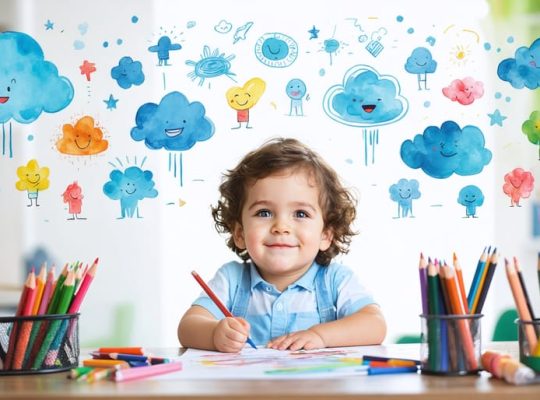Stories have the remarkable power to heal, teach, and transform lives – especially when working with children. Understanding the seven essential elements of storytelling isn’t just about crafting engaging narratives; it’s about creating safe spaces for emotional expression and growth.
As mental health professionals, educators, and parents, we’ve witnessed how well-structured stories can help children process complex emotions, develop resilience, and make sense of their experiences. Whether you’re using stories in therapy sessions, classroom activities, or bedtime routines, mastering these fundamental elements will enhance your ability to connect with and support the children in your care.
These seven storytelling elements – character, setting, plot, conflict, theme, point of view, and resolution – work together like instruments in an orchestra, each playing a crucial role in creating a meaningful narrative experience. When thoughtfully applied, they become powerful tools for addressing anxiety, trauma, and social challenges while nurturing emotional intelligence and self-expression.
Let’s explore how these elements can be purposefully integrated into therapeutic storytelling, creating narratives that don’t just entertain, but heal, empower, and transform young minds.
Building Trust Through Character Development

Creating Safe Spaces with Fictional Friends
Children naturally form deep connections with story characters, creating emotional safe havens that help them express their inner world and navigate challenging experiences. These fictional friends become trusted confidants, offering comfort and understanding when real-world situations feel overwhelming. Whether it’s a brave princess helping them face their fears or a kind-hearted animal teaching them about friendship, these characters provide children with emotional anchors and positive role models.
Through these relationships, children can safely explore difficult emotions and life situations from a comfortable distance. A child who’s anxious about starting school might find solace in a story about a nervous rabbit’s first day, while one dealing with sibling rivalry might relate to a tale about learning to share. These character connections create psychological safety nets, allowing children to process their experiences and emotions at their own pace while feeling understood and supported.
Character Archetypes That Resonate
In therapeutic storytelling, certain character types consistently help children process their emotions and experiences. The Hero figure, who overcomes challenges through perseverance, shows children they can face their own difficulties. The Wise Guide character, like a grandparent or teacher, represents support and guidance, reminding children they’re not alone in their journey.
The Trickster character, often appearing as a clever animal or playful friend, helps lighten heavy topics and teaches problem-solving through wit rather than force. Children also connect strongly with the Underdog, who succeeds despite limitations, as this character builds confidence and hope.
For younger children, Animal Characters often work wonderfully as they’re both familiar and non-threatening. They allow children to explore complex emotions from a safe distance. The Transformer character, who changes and grows throughout the story, helps children understand that change is natural and positive.
Remember that these characters work best when they reflect aspects of the child’s own experiences while maintaining enough distance to feel safe and engaging.
The Power of Plot in Processing Emotions
Conflict Resolution Through Story
Stories provide a safe space for children to explore conflict resolution skills through the experiences of characters they connect with. When characters face challenges, children naturally engage in problem-solving alongside them, considering different solutions and their potential outcomes.
By following a character’s journey through conflict, children learn valuable strategies like identifying the problem, brainstorming solutions, and evaluating consequences. For example, when a story’s protagonist deals with a playground dispute, children can discuss alternative approaches and their likely results before seeing how the character resolves the situation.
Parents and educators can enhance this learning by pausing at crucial plot points to ask questions like “What do you think the character should do?” or “How else could they handle this situation?” This interactive approach helps children develop critical thinking skills while building their emotional intelligence.
Stories also demonstrate that conflicts can have multiple solutions and that it’s okay to make mistakes along the way. This understanding helps reduce anxiety around real-world problem-solving and encourages children to approach conflicts with creativity and resilience rather than fear or avoidance.
Emotional Journey Mapping
Stories have a unique way of helping children process and control their emotions by mirroring their own emotional journeys. Just as children experience ups and downs throughout their day, stories follow similar patterns that help validate and normalize these feelings.
Think of a story arc as an emotional road map. It starts with a familiar situation, encounters challenges that create tension or worry, and eventually leads to resolution and relief. This pattern matches how children naturally process difficult experiences – from feeling scared or frustrated to finding comfort and understanding.
When children identify with characters going through similar emotional experiences, they feel less alone in their struggles. A story about a child overcoming fear of the dark, for instance, allows young readers to see their own fears reflected and conquered in a safe, supportive way.
By following these emotional journeys through stories, children learn that all feelings are temporary and that challenging situations can have positive outcomes. This understanding builds emotional resilience and helps them navigate their own life experiences with greater confidence.

Setting: Creating Safe Spaces in Stories
When children engage with stories, the setting acts as more than just a backdrop – it creates an emotional container where healing and growth can take place. A well-crafted setting provides children with a sense of safety and predictability, allowing them to explore difficult emotions and experiences from a comfortable distance.
Think of setting as creating a cozy reading nook in your story. Just as children feel secure in their favorite corner of the house, characters need a space where they can feel protected while facing challenges. This might be a magical forest where talking animals offer wisdom, a friendly classroom with an understanding teacher, or even a make-believe world where children have special powers to overcome their fears.
In therapeutic storytelling, settings can mirror safe spaces from the child’s real life or introduce new environments that represent emotional security. For example, a story about a child dealing with anxiety might take place in a gentle garden where flowers whisper encouraging words, or a tale about building confidence could unfold in a treehouse that grows taller as the protagonist becomes braver.
The key is consistency and predictability within the setting. Even when characters face difficulties, the environment should maintain elements that provide comfort and stability. This might include recurring friendly characters, familiar locations, or reliable natural elements like a wise old oak tree or a kind moon that watches over the story’s events.
When creating settings for therapeutic stories, remember that physical safety features (like protective walls or secure homes) can symbolize emotional security, helping children process their experiences while feeling supported and understood.

Theme: Finding Meaning and Hope
Stories have an incredible power to help children discover meaning in their experiences and find hope during challenging times. Through carefully crafted themes, children can explore complex emotions and life situations in a safe, relatable way. When children connect with a story’s theme, they often realize they’re not alone in their feelings and challenges.
For example, a story about a small bird learning to fly might carry themes of perseverance and self-belief, helping children understand that it’s normal to feel scared when trying something new. These universal themes can help children build lasting self-esteem and develop resilience as they identify with characters who overcome similar obstacles.
Themes also provide children with emotional vocabulary and frameworks to process their experiences. A story about friendship might explore themes of loyalty, forgiveness, and acceptance, giving children reference points for understanding their own relationships. When children recognize these themes in stories, they’re better equipped to navigate similar situations in their own lives.
Additionally, hopeful themes can serve as emotional anchors during difficult times. Stories that emphasize themes of courage, family support, or personal growth can remind children that challenges are temporary and that positive change is possible. This is particularly valuable when children are dealing with anxiety, loss, or major life transitions.
When selecting stories for children, look for themes that resonate with their current experiences while offering constructive perspectives and solutions. The right theme can transform a simple story into a powerful tool for emotional development and healing.
Dialogue: Giving Voice to Feelings
When children struggle to express difficult emotions directly, dialogue between story characters can provide a safe outlet for these feelings. Through character conversations, children can explore complex emotions like anxiety, anger, or sadness from a comfortable distance.
Consider creating a dialogue where one character tells another about feeling nervous on the first day of school. This conversation might go: “My tummy feels all squiggly inside,” says the young rabbit to his mother. “Is that normal?” This simple exchange validates children’s anxiety while showing them they’re not alone in their feelings.
Characters can also model healthy emotional expression. For example, instead of having a character say “I’m mad!” and storm off, you might write: “I feel angry because you took my toy without asking. Can we talk about it?” This demonstrates constructive ways to communicate difficult feelings.
Remember to match the dialogue style to your child’s age and understanding. Younger children benefit from simple, direct conversations with clear emotional language, while older children can handle more nuanced exchanges that explore multiple perspectives and complex feelings.
Using animal characters or fantastical beings often helps children feel more comfortable discussing challenging topics. A worried dragon or a sad unicorn can help normalize these emotions while keeping the conversation engaging and non-threatening.
Parents and caregivers can encourage children to create their own character dialogues, asking questions like “What might the bear say to help his friend feel better?” This empowers children to develop emotional vocabulary and problem-solving skills through storytelling.
Metaphor and Symbolism in Healing
Children naturally gravitate toward metaphors and symbols in stories because these elements help them make sense of complex emotions and experiences. Just as a brave knight fighting a dragon might represent a child confronting their fears, symbolic elements in storytelling create a safe distance from which children can explore challenging feelings.
When we incorporate metaphors into therapeutic storytelling, we give children a powerful vocabulary for expressing themselves. For instance, a child struggling with anxiety might relate to a butterfly emerging from its cocoon, understanding that transformation and growth can be both scary and beautiful. These symbolic representations allow children to process their emotions without feeling overwhelmed or directly confronted.
Animals often serve as particularly effective metaphors in children’s stories. A lonely penguin finding its flock might help a child process feelings of isolation, while a determined ant overcoming obstacles could inspire resilience. Combined with visual storytelling elements, these metaphors become even more impactful, creating lasting impressions that children can draw upon during difficult times.
Weather and natural phenomena also work well as symbolic tools. A storm passing to reveal sunshine might represent hope after hardship, while a seed growing into a tree can symbolize personal development and strength. These universal symbols help children understand that their emotional experiences are natural and temporary, just like the changing seasons.
By choosing appropriate metaphors and symbols, we create a bridge between children’s inner worlds and their ability to express themselves, making the healing journey feel more accessible and less intimidating.
Putting It All Together: The Therapeutic Story Journey
Creating therapeutic stories doesn’t have to be overwhelming. Start by identifying the challenge your child or client is facing, whether it’s anxiety, self-esteem issues, or behavioral concerns. Think about what message or lesson would be most helpful, and let this guide your story’s development.
Begin with a character your listener can relate to – perhaps a young animal or child facing similar struggles. Set the scene in a familiar yet imaginative environment that feels safe but allows for adventure. As you develop the plot, weave in metaphors that mirror real-life challenges, but keep them gentle and age-appropriate.
Remember to include emotional elements that validate your listener’s feelings. For example, if your story addresses fear of the dark, let your character express their worries openly before finding their courage. Introduce supporting characters who offer wisdom or help, representing the real-world support system available to your listener.
Pay special attention to the resolution – make it realistic and achievable. Rather than magical solutions, show how the character overcomes challenges through internal growth, asking for help, or learning new coping strategies. End with a sense of hope and accomplishment that your listener can draw inspiration from.
Take time to practice the story before sharing it, focusing on your pacing and tone. Watch for your listener’s reactions and be ready to adjust the story as needed. Sometimes the most powerful therapeutic moments come from the discussions that follow the storytelling.
The seven elements of storytelling provide powerful tools for healing, growth, and emotional development. Through characters, plot, setting, conflict, theme, dialogue, and resolution, children can safely explore their feelings, understand complex emotions, and develop coping strategies. By incorporating these elements thoughtfully in therapeutic storytelling, we create safe spaces where children can process their experiences, build resilience, and write their own stories of hope and healing. Remember, every child’s story matters, and through storytelling, we help them find their voice and path to emotional well-being.




